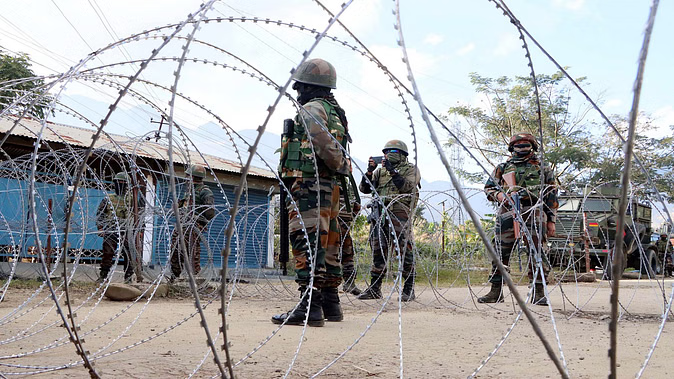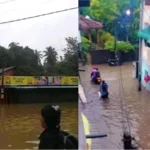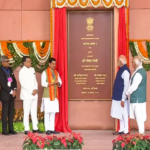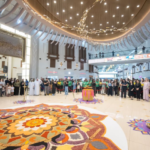Imphal, An active cadre of the banned organization UPPK was arrested from the Kangla Pat area of Imphal West district. He has been identified as Yumnam Prem Meitei (23). Another insurgent linked to the banned organization KCP (PWG) was arrested from the parking area of Polo Ground in Imphal West district.
Security forces have arrested four insurgents associated with various banned organizations from Imphal East and West districts in Manipur. Police provided this information on Sunday. Security forces are continuously conducting operations against insurgents in the state. A large number of insurgents have been arrested this month in actions taken by security forces.
Four insurgents arrested from four different districts
An active cadre of the banned organization UPPK was arrested from the Kangla Pat area of Imphal West district. He has been identified as Yumnam Prem Meitei (23). On Friday, an insurgent linked to the banned organization KCP (PWG) was arrested from the parking area of Polo Ground in Imphal West district. He has been identified as Nanao (43). According to police, he was involved in extortion from shops in the valley area.
As per the police statement, he was involved in threatening women and allegedly mediating disputes between various groups through so-called ‘kangaroo courts.’ On Saturday, another active cadre of the banned organization PREPAK was arrested from Seijang Awang Leikai in Imphal East district. Additionally, an active member of the banned People’s Liberation Army (PLA) was arrested from Napeet village in Imphal East district on Saturday.
On the same day, security forces seized a .303 rifle, a locally made .32 pistol, a locally made single-barrel rifle, two improvised mortars, one improvised rocket bomb, three improvised hand grenades, ammunition, and other materials from Lamjang village in Churachandpur district.
Kangla Pat
Kangla Fort, also known as Kangla Palace, is a historic and culturally significant site located in Imphal, Manipur, India. It served as the traditional seat of the Manipuri kings for centuries and holds great importance in the region’s history and identity. The fort complex includes ancient temples, royal buildings, and sacred spots, reflecting Manipur’s rich heritage and its resistance during British colonial rule. Today, it is a protected monument and a symbol of Manipuri pride.
Polo Ground
The Polo Grounds was a historic stadium in New York City, primarily known as the home of the New York Giants baseball team (1883–1957) and later the New York Mets (1962–1963). Originally built in 1876 for polo matches, it became a famous baseball venue with a distinctive horseshoe shape and short outfield fences. The stadium was demolished in 1964 after the teams moved to newer facilities.
Seijang Awang Leikai
Seijang Awang Leikai is a historic locality in Manipur, India, known for its cultural significance and traditional Meitei heritage. The area is part of the larger Seijang region, which has played a role in preserving Manipuri customs, arts, and community life. While specific historical details may be limited, it remains an important cultural site for the local Meitei people.
Napeet village
Napeet Village is a small, traditional settlement located in northern Kenya, primarily inhabited by the Samburu people, a semi-nomadic pastoralist community. The village is known for its rich cultural heritage, including vibrant beadwork, traditional dances, and a deep connection to the surrounding arid landscape. Historically, the Samburu have maintained their way of life despite modernization, relying on livestock herding and preserving their unique customs for generations.
Lamjang village
Lamjang Village is a traditional settlement in Nepal, known for its rich cultural heritage and scenic beauty. Historically, it has been home to the Gurung community, an ethnic group with deep-rooted traditions in agriculture, handicrafts, and military service (notably the Gurkhas). The village offers a glimpse into rural Nepalese life, with terraced fields, stone houses, and vibrant local festivals.
Churachandpur district
Churachandpur district is a culturally rich region in the Indian state of Manipur, known for its diverse tribal communities, including the Kuki, Paite, and Hmar groups. Named after Maharaja Churachand Singh, a former ruler of Manipur, the district has a history of tribal traditions, resistance, and vibrant folk arts. It is also notable for its scenic landscapes, including hills, rivers, and forests, which play a key role in local livelihoods and culture.
Imphal East
Imphal East is a district in the Indian state of Manipur, known for its rich cultural heritage and historical significance. It includes parts of Imphal, the state capital, and features landmarks like the Kangla Fort, a former royal palace with deep ties to Manipuri history. The region played a key role during World War II, particularly in the Battle of Imphal (1944), a turning point in the Burma Campaign.
Imphal West
Imphal West is a district in the Indian state of Manipur, with Imphal city as its administrative headquarters. Historically significant, it was a key site during World War II, notably in the Battle of Imphal (1944) between British and Japanese forces. Today, it is a cultural and political hub, home to landmarks like the Kangla Fort and Manipur State Museum, reflecting the region’s rich heritage.






